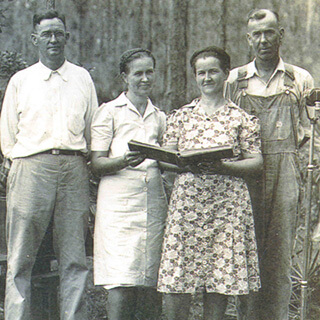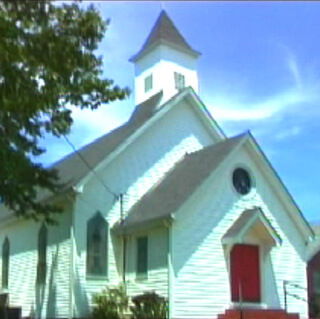Overview
Timothy Eriksen reviews David Warren Steel and Richard H. Hulan's The Makers of the Sacred Harp (Urbana: University of Illinois Press, 2010).
Review
 |
| Cover of David Warren Steel and Richard H. Hulan's The Makers of the Sacred Harp, 2010. |
Shape-note singing from The Sacred Harp tunebook is one of the most vibrant and long-lived singing traditions in the US South. First published in 1844 by Georgia compilers B.F. White and E.J. King, the book has been constantly used and occasionally revised. For the last several decades its popularity has been spreading. Even before the publication of the 1991 edition of The Sacred Harp, rumors circulated among Sacred Harp singers that musicologist and singer Warren Steel was expanding the biographical and historical notes of the book for a separate volume. In Makers of the Sacred Harp, Steel and contributing author Richard Hulan present The Sacred Harp in regional and historical perspective as a work in progress that “stands on the persistent collaboration of generations of composers, songbook compilers, editors, and revisers, singing teachers, song leaders, and singers of all ages” (xi). Through painstaking identification of the “who, where, when and how” of the tunebook’s creation, the authors portray a living tradition rooted in people, places and historical moments. Essays addressing key elements in The Sacred Harp’s origin, development, and character comprise the first quarter of Makers, setting the stage for the book’s biographical sketches, tune and text sources, images and tables. This review will discuss these essays, with special attention to the historical context and growth of The Sacred Harp.
Sacred Harp singing remains unfamiliar enough to most people that basic description continues to be a necessary prelude to any discussion. Steel provides two summary descriptions. “Sacred Harp singing is a community musical and social event emphasizing participation, not performance, where people sing from a tunebook called The Sacred Harp, printed in music notation using four shaped notes. Since the nineteenth century, Sacred Harp singings have employed a distinctive ‘hollow square’ seating arrangement and rotation of leaders; they begin each song with solmization followed by one or more verses of text” (xi). Steel notes the music’s unique sound, the core practices of a communal meal, and forgoing of “contentious discussion of politics and denominational religion” (3). The book moves rapidly from the general into the specific. Fortunately there are abundant resources for introductory encounters with the tradition, including many opportunities to attend a singing.
Steel discusses The Sacred Harp’s editors and contents, its relationship to other shape-note tunebooks, and the economics and technology of early publishing. Steel presents early composers in The Sacred Harp not as rustic daguerreotypes but as representatives of “a diverse range of wealth, education, and influence, during the age of Jacksonian democracy” (11). He characterizes the early singing schools and conventions less as sites of cultural preservation than events that “contributed to ‘breaking the bonds of custom, offering new experiences, calling out new institutions and activities’” (11, quoting Turner, 1920). The backdrop to The Sacred Harp’s emergence is not the stereotypical impoverished, rural isolation often associated with southern “folk” or “Appalachian” music, but the rapid growth and booming economy of a culture on the move.
Much of that movement was westward. Steel discusses the causes and consequences of migration into the Chattahoochee Valley and much of western Georgia in the decades leading to the first publication of The Sacred Harp and the significance of this region to the book’s creation. Settlement by whites and enslaved blacks was made possible by treaties and appropriations between 1805 and 1836 through which the Creek and Cherokee people were removed from their land and the state. For black and white residents, the Chattahoochee Valley became an important locus of musical and cultural development. In the case of the “revival spiritual songs” that began to appear in great numbers in 1840s tunebooks, including The Sacred Harp, Steel speculates that some may have had their origin in a preexisting repertoire shared by both groups.
Among those who moved west to the Chattahoochee Valley were Sacred Harp editors B.F. White and E.J. King. Born in 1800, White came to Harris County from Spartanburg, South Carolina, not long before the publication of The Sacred Harp. Twenty years his junior, King had arrived in what would become Talbot County as a child when his parents moved from Wilkinson County to land acquired in an 1827 lottery. According to Steel, King probably provided much of the financial backing for the tunebook as he was a member of a “wealthy family on a large plantation” while White was “still establishing himself as a farmer and landowner” (6).
Steel examines multiple links between The Sacred Harp and the Civil War, beginning with the cotton boom that helped make the book possible. By Steel’s count, at least fourteen composers represented in the 1991 edition served in the Confederate forces, including at least three who died in the war. As revealed in poignant letters home, some soldiers brought their Sacred Harps with them for use around the campfire, a testament to their love of the music considering the volume’s size and weight. A number of composers less directly involved in the book’s production served the Union side, including the Canadian-born W.E. Chute who, after the war, maintained a friendly relationship with Georgia composer and Confederate William Hauser. The fourth edition of the book was published in 1870, the year Georgia rejoined the Union. A few accounts of singing directly after the war give a glimpse of the music’s nostalgic and restorative power, suggesting the role the trials of war and Reconstruction may have played in the continued growth and appeal of Sacred Harp music.
Steel examines institutions surrounding and nurturing The Sacred Harp, including the roles of family, professions, teachers, and tradition. Musical family ties are common among singers and composers represented in The Sacred Harp. Steel traces such relationships in eighteenth-century New England, nineteenth-century Georgia, and among contemporary singers. One remarkable story concerns the three Lancaster sisters of Georgia, all singers and fine Sacred Harp composers, whose family music history goes back to sixteenth century Venice and the court of Henry VIII.
Discussing the complexities of The Sacred Harp in musical detail can be tricky, especially when addressing an audience with an uneven range of knowledge. Steel provides an accessible technical discussion of what makes Sacred Harp music tick, what makes the diverse range of tune types distinctive, how they have evolved, which properties they share and what distinguishes them. For historians and Sacred Harp enthusiasts, Steel’s discussion of John Playford’s role in establishing precedents for several current practices as clerk and music director at London’s Temple Church of the mid-seventeenth century is one of the book’s most interesting sections.
 |
| Original Sacred Harp title page, 1911. Digitized by Aldo Ceresa, 2011. |
The Makers of the Sacred Harp stands out from other works on American folk hymnody in its attention to the hymn texts and their authors, the focus of Richard Hulan’s contributions. Hulan observes that “for the past seventy-five years, serious scholarly attention to early American religious folksong has overwhelmingly approached the material as music” and the relatively few studies focused on the texts have tended to be by church music professionals or denominational insiders (57). Much of the lyrical content in The Sacred Harp comes from the well documented work of English evangelicals such as Watts, Wesley, and Newton. Hulan’s concern is the far more elusive history of early nineteenth-century revival and camp-meeting hymns and the frontier preachers who wrote them. These authors are rarely identified in hymn collections since they didn’t seek recognition; some hymns arose spontaneously, and most were circulated and adapted in a combination of oral transmission, manuscript, and evanescent print forms. Hulan provides new knowledge about hymn writers, the role of African Americans in frontier hymnody, and the relationship between print, manuscript, and performance. The prominence of the frontier hymns in The Sacred Harp is one of its distinguishing characteristics and Hulan’s research, which he likens to “chasing rainbow makers,” brings new light and a welcome perspective.
Rooting musical practices in the lives of individuals and individual creativity in broader cultural context, The Makers of the Sacred Harp is an indispensable study of the countless acts of creative brilliance and maintenance, both individual and collective, involved in the unfinished making of The Sacred Harp. Enthusiastically welcomed by Sacred Harp singers and scholars of American hymnody, it should appeal to a broader readership as a fascinating work of history.
About the Author
Tim Eriksen is a PhD candidate in ethnomusicology at Wesleyan University, a GRAMMY-nominated musician and a Sacred Harp singer. He coordinated the Sacred Harp music in the film Cold Mountain, and has collaborated with pianist Omar Sosa and composer Evan Chambers. He has taught at Dartmouth College, Hampshire College, Amherst College, the University of Minnesota and Smith College.
Recommended Resources
Bealle, John. Public Worship, Private Faith: Sacred Harp and American Folksong. Athens: University of Georgia Press, 1997.
Cobb, Buell Jr. The Sacred Harp: A Tradition and Its Music. Athens: University of Georgia Press, 1978.
Miller, Kiri. Traveling Home: Sacred Harp Singing and American Pluralism. Urbana: University of Illinois Press, 2008.
Steel, David Warren and Richard H. Hulan. The Makers of the Sacred Harp. Urbana: University of Illinois Press, 2010.
Webb, Chloe. Legacy of the Sacred Harp. Fort Worth: Texas Christian University Press, 2010.
Film
Awake My Soul: The Story of the Sacred Harp.
Directed by Matt and Erica Hinton. Produced by Matt Hinton. Awake Productions, 2006.
http://www.awakemysoul.com.
Sweet is the Day: A Sacred Harp Family Portrait.
Directed by Jim Carnes. Produced by Erin Kellen. The Alabama Folklife Association, 2001.
http://www.folkstreams.net/film,44.
Links
Sacred Harp Musical Heritage Association
http://www.fasola.org.
Timothy Eriksen's website
http://timeriksenmusic.com.

